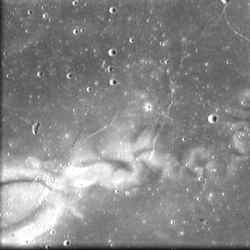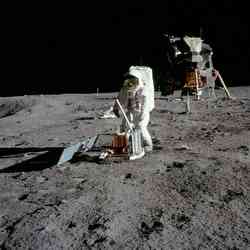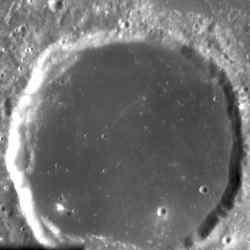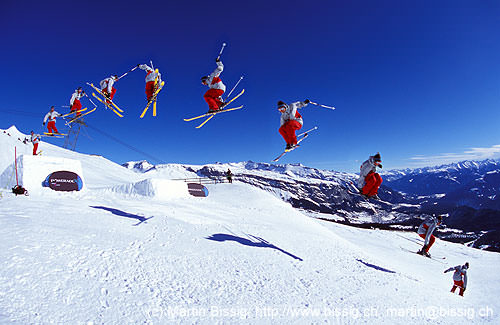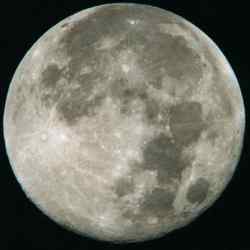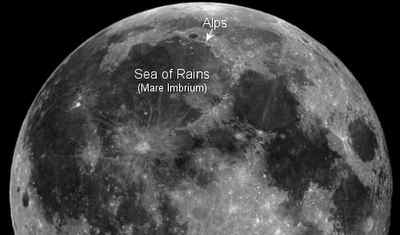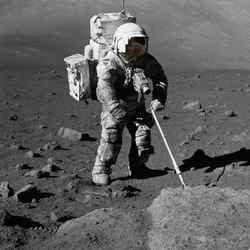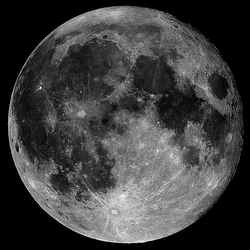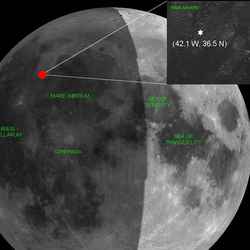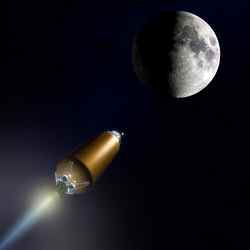
An artist’s conception of LRO on its way to the moon. Image credit: NASA Click to enlarge
NASA announced a new spacecraft today that will search for ice at the Moon’s southern pole: the Lunar CRater Observation and Sensing Satellite (LCROSS). The spacecraft will launch as a secondary payload with the Lunar Reconnaissance Orbiter in 2008. As it approaches the Moon, LCROSS will split into two spacecraft. The first will smash into the Moon’s south pole, and the second will fly through the resulting plume, analyzing it for traces of water. This mission will be developed on a shoestring; NASA has allocated a total of $80 million for its development.
NASA today announced that a small, ‘secondary payload’ spacecraft, to be developed by a team at NASA Ames Research Center, Moffett Field, Calif., has been selected to travel to the moon to look for precious water ice at the lunar south pole in October 2008.
The smaller secondary payload spacecraft will travel with the Lunar Reconnaissance Orbiter (LRO) satellite to the moon on the same rocket, the Evolved Expendable Launch Vehicle (EELV), to be launched from Kennedy Space Center, Florida. The NASA Ames team proposed the secondary payload mission, which will be carried out by the Lunar CRater Observation and Sensing Satellite (LCROSS).
“The LCROSS mission gives the agency an excellent opportunity to answer the question about water ice on the moon,” said Daniel Andrews of NASA Ames, whose team proposed the LCROSS mission. “We think we have assembled a very creative, highly innovative mission, turning the upper stage of the rocket that brought us to the moon into a substantial impactor on the moon.”
After launch, the secondary payload LCROSS spacecraft will arrive in the lunar vicinity independent of the LRO satellite. On the way to the moon, the LCROSS spacecraft’s two main parts, the Shepherding Spacecraft (S-S/C) and the Earth Departure Upper Stage (EDUS), will remain coupled.
As the spacecraft approaches the moon’s south pole, the upper stage will separate, and then will impact a crater in the south pole area. A plume from the upper stage crash will develop as the Shepherding Spacecraft heads in toward the moon. The Shepherding Spacecraft will fly through the plume, and instruments on the spacecraft will analyze the cloud to look for signs of water and other compounds. Additional space and Earth-based instruments also will study the 2.2-million-pound (1000-metric-ton) plume.
“The LCROSS mission will help us determine if there is water hidden in the permanently dark craters of the moon’s south pole,” said Marvin (Chris) Christensen, Robotic Lunar Exploration Program (RLEP) manager, and acting director of NASA Ames. “If we find substantial amounts of water ice there, it could be used by astronauts who later visit the moon to make rocket fuel,” Christensen added.
Earlier, NASA had requested proposals internally from its NASA field centers for existing or reasonably matured concepts for secondary payloads that would offer cost-effective contributions to RLEP.
To prepare for the return of astronauts to the moon, NASA will conduct various RLEP robotic missions from 2008 to potentially 2016 to study, to map and to learn about the lunar surface. These early missions will help determine lunar landing sites and whether resources, such as oxygen, hydrogen and metals, are available for use in NASA’s long-term lunar exploration objectives.
“Establishing research stations on the moon will give us the experience and capabilities to extend to Mars and beyond,” noted robotics deputy program manager Butler Hine of Ames.
“An exploration science program with a sustained human presence on the moon gives us the opportunity to conduct fundamental science in lunar geology, history of the solar system, physics and the biological response to partial (Earth) gravity,” said Christopher McKay, lunar exploration program scientist at Ames.
The space agency specified that the winning proposal must demonstrate an affordable concept beneficial to RLEP, according to the document that asked NASA centers to submit suggestions for the secondary payload. NASA noted that the secondary payload mission should cost no more than $80 million. NASA also required that the payload mass not exceed 2,205 pounds (1,000 kilograms).
NASA encouraged its field centers to team with industry to develop proposals. On Jan. 10, NASA issued a request for information to industry to allow businesses to provide secondary payload concepts to NASA. Each NASA center reviewed ideas from industry as well as secondary payload concepts developed internally.
NASA asked that the concepts advance the Vision for Space Exploration to include missions that evolve lunar science, characterize the lunar environment and support identification sites for future human missions as well as the utility of those sites.
The space agency said that it was looking for missions that demonstrate technology that could enhance future exploration, that show operational schemes to support exploration, that develop or emplace infrastructure in support of exploration, that advance commercial opportunities and those missions that would collect engineering data to support the Constellation program. That program is developing NASA’s new spaceship, the Crew Exploration Vehicle.
For images related to the LCROSS mission, please visit:
http://www.nasa.gov/centers/ames/multimedia/images/2006/lunarorbiter.html
For additional high-resolution images of the and historic information, please visit:
http://www.nasa.gov/centers/ames/news/releases/2004/moon/moon.html
http://nssdc.gsfc.nasa.gov/planetary/lunarprosp.html
http://science.nasa.gov/newhome/headlines/ast31jul99_1.htm
Original Source: NASA News Release

